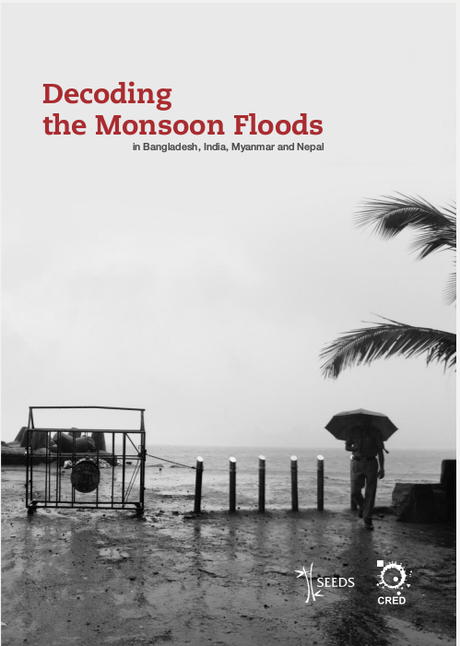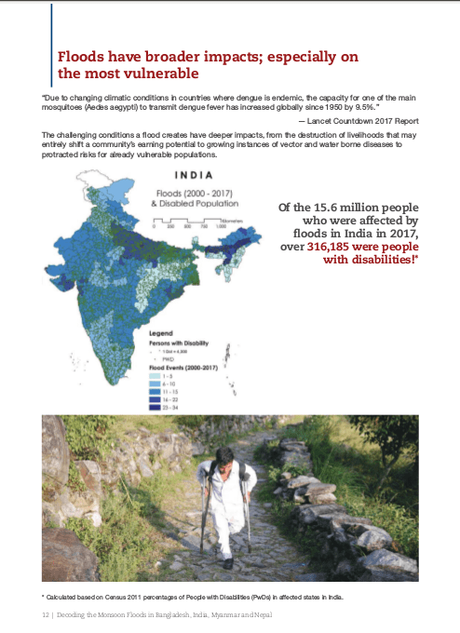Floods top the list of disasters in India. In fact, it is creating a new dimension to its devastating impacts. Around 60% of smart cities fall in high flood risk areas. A joint report by SEEDS and Centre for Reseasrch on the Epidemology of Disasters (CRED) reveals many astonishing facts in this regard. The title of the report is Decoding The Monsoon Floods in Bangladesh, India, Myanmar, and Nepal. In fact, there are many local agencies in these countries like Bangladesh, Nepal, India, and Myanmar are working in an attempt to gather some useful disaster data between 2000 and 2017. Fast collection of meaningful data with high amount of accuracy is a challenging task in such cases. In absence of this, the whole process and effort becomes tardy. And when you have this important data in place in right volume and sanctity, its analysis is the next critical task.

The origin of this report is from the Safe Communities Innovation Lab initiative that works around Bangladesh. Its primary goal is to find innovative ways to enhance disaster preparedness. Fighting against a disaster itself is an uphill task. In fact, it is a teamwork. This report reveals that floods are the most devastating disasters in the region. As a matter of fact, there have been more than 360 flooding events that include both flood and cyclones. This data is of four countries over the last 18 years. That takes almost 75% of the total disasters in this part of Asia.
Monsoon Floods Top All Kind Of Disasters
Dr Manu Gupta, Executive Director, SEEDS says, “Business, as usual, is not an option when humanitarian needs are increasing and the gap between need and aid widening. Informed by the kind of revealing data that we are discussing today, disaster management plans need to be disruptively innovative. They need to be able to fill this gap within available resources, and innovations must be led by what works at the community level.” He emphasizes on the importance of such critical data that can help most of the stakeholders in appropriate decision making and timely actions. These stakeholders include governments, civil society, and most importantly the public that is at risk.

Dr Debarati Guha-Sapir, Director, Centre for Research on the Epidemiology of Disasters (CRED) says, “We are witnessing a disturbing trend of a large number of climate-induced disasters, led by flood events that are impacting communities globally. The launch of this regional report is a huge step towards better understanding of local nuances of disaster events. Higher resolution data at regional, national and community levels will enable a better understanding and better-contextualised solutions to growing disaster risks that affect us all.”
The report reflects that more than 2000 cities or towns have faced over 11 floods in the last 18 years. These districts that comprise these 2000 cities and towns are a high-risk radar. As a matter of fact, there are more than 55% planned smart cities in India that are in those districts having a higher count of flood events. It signifies the number of investments that will go in securing these areas against future risks. So, look at the huge cost of making these cities smart. And then another chunk of big investment in securing these cities against disasters.
Monsoon Floods And Cyclones Together Take The Biggest Share of Disasters
Dr Anshu Sharma, Co-founder and Mentor, SEEDS, says, Since 2000, India has faced 215 flooding events both from floods and cyclones. This accounts for 77% of all disaster events. Assam is the most flood-prone state, with areas like Lakhimpur reporting over 30 flood events within this period. Even known drought-prone areas of Gujarat and Rajasthan have witnessed more floods than the country’s average in the last 18 years. Unpredictability, urbanization, and invisibility of flood risk are major concerns that need to be addressed urgently.”
The report indicates that with a scale of this volume it is quite difficult to get enough resources to capture accurate losses and damages. Many times the sources of information are informal and the information is not too precise. That is where communities play a major role to cope up with these limitations. Of course, what a community can do is incomparable to anything else. In fact, as the report suggests, helping and creating these communities and investing in them will definitely bear more fruitful results. Only thing is the policies must be there in place and awareness should be there at community levels.
It is interesting to know that the Centre for Research on the Epidemiology of Disasters is actively operational for more than 4 decades. Its primary focus is to work in the field of international disaster and conflict health studies. It also hosts EM-DAT: The Emergency Events Database. This is, in fact, a global disaster database with its development starting in 1988. It aims to help significantly and factually in decision making and analytics in case of disaster preparedness. In fact, It also helps in vulnerability assessment and setting the priorities. It operates from the University of Louvain School of Public Health in Brussels.
SEEDS Is Doing A Tremendous Work For Disaster Risk Management
SEEDS is into operations for last 24 years. Its primary goal is to assist governments, corporations, civil societies, communities, and UN agencies via their disaster risk management mechanism. The whole ecosystem is community based. It is a humanitarian organization working on disaster resilience and various other programmes in many countries primarily in Asia. These include India, Bangladesh, Myanmar, and Vietnam.
